- Home
- About Us
- Join/Renew
- Member Benefits
- Member Pages
- Log In
- Help
- Museum Store
Hope you have a good Thanksgiving planned.
I have developed a pin hole leak in the drivers side water jacket on the Pierce. It is a corrosion related failure. I was trying to locate a replacement and thought that you might have a lead. Any assistance would be appreciated. Thanks for your help.
I have a water jacket that is not correct for my ’29 but I do not know when the change was made to the water jacket to relocate the water inlet just a little bit further back.
If someone can chime in on whether it would fit your ’30, or if you know if it would fit your car, I have one.
And you’re not all that far away, I could deliver it.
Would be a good excuse to stop and have some Phil’s BBQ. 
Syd, A quick search of “water jacket” under PAS’ Parts & Services lists 29-38 Eights water jacket available through:
Blonder-Murray Reproductions
Dave Murray
5801 38th Ave. NW
Gig Harbor, WA 98335-8237
Phone: 253/229-9573
And Olson’s has the gaskets – I’ve just replaced the water jacket gasket on our ’36.
I think they fit 29-32 and 33 to 38. No longer being made as far as I know. Cislak had used ones at Hershey this year.
I have three extra that are available, if Craig’s does not work for you. The difference in the early and late for 8’s is, as mentioned, inlet hole location.
-one very good cover, no back distribution plate
-one excellent complete, was only on a car for a short time, may have to move inlet
-one complete surface rusty one, condition unknown
David, thanks for your response. Point of clarification please. Were the ones that you have for the “30 or were they for the later years.
I tried emailing you based on the email address in the roster but it came back as undeliverable. Thanks.”
Syd, it’s [email protected] … I’ll get measurements today, I think both of my “good” ones have been modified.
The manifolds are all identical except for location of water inlet in the side, the earlier ones have inlets about 6 inches or so further forward.
If you need just the outside cover, this is a good one. It has been modified with the inlet moved forward and would fit your car. To be sure, send me a measurement from front of cover to hole center and we can verify. You’d have to either use the distribution plate off your old one, or make a new one.
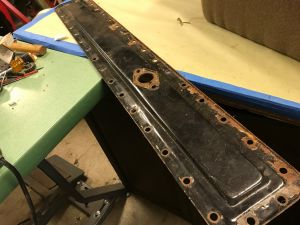
back of manifold, no distribution plate
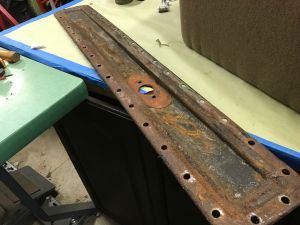
I got a welder to run a small bead over a pinhole on my Series 80’s cover wheh she sprang a lead. Ta da! No more leak
Just a suggestion
Here is a close up of the measurements on the water jackets I have.
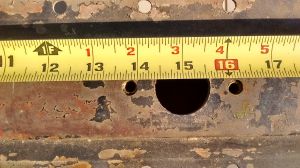
Measured from the front edge of the entire assembly.
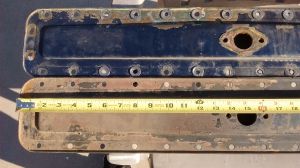
Back sides of the assemblies.
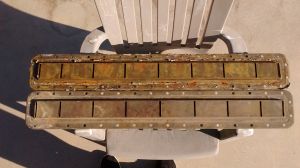
Obviously both need to be plated but they are fully functional.
Randy is on to something. If the overall water jack isn’t thin, a TIG in good hands could fill in the hole nicely.
The covers are hard to weld, as usually the area is bigger than you realize and there usually isn’t anything to weld to. A patch would work if you have an area big enough to weld to. The problem with welding is the cover is so thin it will twist and warp severely, so you need to clamp it down and then it still will have issues afterwards, but with careful attention you can usually get them close enough to seal against the block. Best bet is sandblast and repair, install new baffles and then straighten it out. The baffle is soldered on.
There was a service bulletin awhile back that had all the dimensions for the jacket with diverter. It was basically a plan to replace the diverter.
I will try to find it but I am still unpacking.
Both of the water jacket covers that Craig showed photos of are for ’33 and later cars.
I count the mounting bolt holes or if you wish the gasket flange holes.
A ’29-32 manifold will have 5 mounting holes plus a little to reach the front bolt hole of the water pump inlet flange.
A ’33-38 manifold will have 6, almost 7 holes in the mounting flange before reaching the front threaded hole for the water pump flange.
When you count the holes in the above pictured manifolds, you can see what i’m referring to.
Greg Long
When I first test drove my 33 1236, came back from about a twenty mile ride and noticed a stream of coolant streaming out of the left side of the engine. Bob Burkhardt, who is connected with the Franklin Museum at Gilmore, was taking care of and showing the car, and he welded up a pinhole on the left water jacket, and the car has been fine for the last two years.
Greg, thanks for identifying what year the water jackets I have will work on.
The blue one was on our ’29 for years, it was just flipped upside down and a molded piece of water hose was used to connect the water pump to the water inlet.
It was funky having the water do a U turn and go into the engine but it still moved water just fine.
I’m not sure when, but it must have been about 13 years ago we sourced a reproduction from Dave Murray and have had that one on the car ever since.
The second one must have come in a batch of parts I picked up in Las Vegas about 10 years ago.
For many years I’ve wanted to make a custom baffle for an 8cylinder manifold. I’d like the baffle to be like the V12’s baffle or diverter plate.
The V12’s have a box, with 1/2″ diameter tubes that vary from ~3″ to ~5″ long that force and direct the cool water to the upper part of the gaps between the cylinders. The Exhaust Valve seats, guides and passageways are the hottest part of the cylinder block, I think they are hotter than the cylinder head above the combustion chamber.
The coolant needs to go between the cylinders to the other side of the water jacket around the cylinders and the valves. With the coolest water going directly to the hottest spots, those critical areas are cooled the best that can be accomplished.
The directed and forced water/coolant so as to hit the hot exhaust passageways and the underside of the exhaust valve seats with the coolest water, fresh from the radiator. This way exhaust valve seat cracking is minimized. The rest of the cylinder area and cylinder head area are well cooled, as long as there is coolant water present in the passageways.
Greg Long
